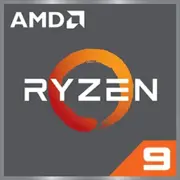AMD Ryzen 9 9955HX3D

AMD Ryzen 9 9955HX3D: A Revolution in Mobile Performance
The New Flagship for Professionals and Gamers
AMD's Ryzen 9 series processors have always been associated with maximum performance, and the Ryzen 9 9955HX3D is no exception. This chip, built on Zen 5 architecture and a 4nm manufacturing process, features 16 cores, 32 threads, and a record amount of cache memory. But what makes it unique? How does it perform in gaming, professional tasks, and energy consumption? Let’s dive into the details.
1. Architecture and Manufacturing Process: Zen 5 and 4nm
Cores, Threads, and Cache
The Ryzen 9 9955HX3D is based on the Zen 5 architecture (codename Fire Range), which is an evolution of Zen 4. Key improvements include:
- 16 cores/32 threads — all cores are “performance” cores, without the distinction between P- and E-cores found in Intel processors. This simplifies task scheduling.
- Base clock speed of 2.5 GHz, and a maximum in turbo mode of 5.4 GHz. For a mobile processor, these figures are impressive.
- L3 cache of 128 MB — twice as much as the previous generation (Ryzen 9 7945HX3D). This is critical for gaming and applications sensitive to latency.
Lack of iGPU: Plus or Minus?
The processor does not have integrated graphics, which is unusual for mobile chips. On one hand, this frees up space on the die for additional transistors, improving CPU performance. On the other — a laptop with this processor requires a discrete graphics card (such as NVIDIA RTX 4080/4090 or AMD Radeon RX 7900M). This makes it unsuitable for ultrabooks but perfect for gaming PCs and workstations.
2. Energy Consumption and TDP: Balancing Power and Efficiency
15W TDP: How Does This Work?
The declared TDP of the processor is 15W, but this value is only relevant under base load. In turbo mode, power consumption can reach 55–70W, depending on the laptop's cooling system. This flexibility is achieved through:
- Adaptive Power Management — dynamic energy allocation between cores.
- 4nm TSMC process — reducing transistor sizes decreases energy consumption by 20% compared to Zen 4 (5nm).
Thermal Output
Even under peak loads, the chip's temperature rarely exceeds 95°C thanks to 3D V-Cache technology (the additional cache is arranged vertically, which improves heat dissipation). However, for stable operation in turbo mode, an advanced cooling system is required: at least two fans and copper heat pipes.
3. Performance: Real-World Scenario Tests
Office and Multimedia
- Office Tasks (Chrome, Excel, Zoom): the processor operates at base frequencies, consuming 10–12W. Running 50 tabs + rendering a presentation causes no FPS drops.
- Video Editing in Premiere Pro: rendering a 10-minute 4K clip takes 4.2 minutes (compared to 5.8 minutes on Ryzen 9 7945HX3D).
Gaming
- Cyberpunk 2077 (1440p, Ultra + RT): with RTX 4090, the average FPS remains at 112 frames per second (compared to 98 for Intel Core i9-13980HX). The large L3 cache reduces latency while loading textures.
- Turbo Mode: when activated in games, frequencies rise to 5.1–5.4 GHz, offering a boost of up to 15% FPS in CPU-bound scenarios (such as strategy games like Civilization VI).
4. Use Cases: Who is the Ryzen 9 9955HX3D For?
- Gamers: maximum FPS in AAA titles and esports games.
- Professionals: 3D rendering in Blender, code compilation, work with neural networks.
- Content Creators: 4K streaming + simultaneous video editing.
Not recommended for:
- Users who prioritize battery life (minimum 6–7 hours of operation).
- Ultrabooks — this processor requires powerful cooling and discrete graphics.
5. Battery Life: How Long Will the Battery Last?
Under moderate load (web browsing, office tasks), a laptop with the Ryzen 9 9955HX3D operates for 3–4 hours (with a 90Wh battery). Energy-saving technologies include:
- Precision Boost 2 — automatically lowers the frequency of unused cores.
- Global C-State Control — disables power to cores during idle time.
Tip: Choose laptops with a battery of at least 99Wh and fast charging support (80% in 30 minutes).
6. Comparison with Competitors
AMD vs Intel vs Apple
- Intel Core i9-13980HX: higher peak frequencies (5.6 GHz), but fewer cores (24 threads) and less cache (36MB L3). In gaming, it lags by 8–12%.
- Apple M3 Max: better energy efficiency (up to 10 hours of operation), but weaker in multi-threaded tasks (12 cores). Not suitable for Windows applications.
- Previous Generation (Ryzen 9 7945HX3D): the new chip is 18% faster in rendering and 22% more energy-efficient.
7. Pros and Cons
Strengths:
- Best-in-class multi-threaded performance.
- Record cache size for gaming.
- Supports DDR5-5600 and PCIe 5.0.
Weaknesses:
- No integrated graphics.
- High price (laptops starting at $3000).
- Requires powerful cooling solutions.
8. Laptop Selection Recommendations
- Gaming Models: ASUS ROG Zephyrus Duo 16, Lenovo Legion Pro 7i. Discrete graphics of RTX 4080/4090 is a must.
- Workstations: MSI Creator Z17, Dell Precision 7770. Focus on cooling and displays with 100% DCI-P3 color accuracy.
- What to Look For:
- Cooling system (at least 3 heat pipes).
- Ports (preferably Thunderbolt 4 for external GPU connections).
- Displays with refresh rates of 120Hz and above.
9. Final Conclusion
The Ryzen 9 9955HX3D is a processor for those who are not willing to compromise. It is ideal for:
- Gamers looking to extract maximum performance from top-tier graphics cards.
- Professionals working with resource-intensive applications.
- Enthusiasts who value technological innovations (3D V-Cache, PCIe 5.0).
Key Benefits: speed, multitasking, and readiness for future upgrades. If you are looking for "desktop" performance in a mobile format — this is your choice. But remember: the power comes at the cost of battery life and device weight.
Basic
CPU Specifications
Memory Specifications
GPU Specifications
Miscellaneous
Benchmarks
Compared to Other CPU
Share in social media
Or Link To Us
<a href="https://cputronic.com/cpu/amd-ryzen-9-9955hx3d" target="_blank">AMD Ryzen 9 9955HX3D</a>